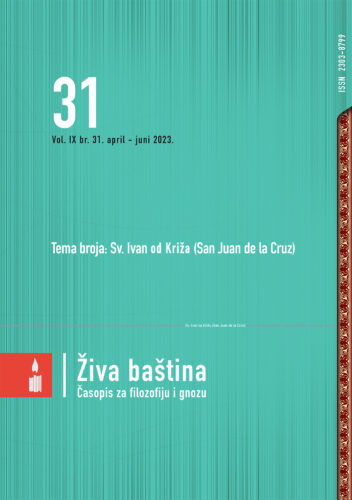UDK 141.336:272
Miguel Asin Palacios u svojoj obimom ne velikoj, ali sadržajno bogatoj knjizi, sagledava sličnosti između mističnih učenja svetog Ivana od Križa i sufizma, tačnije rečeno šazilijskog sufijskog pravca, te mogući utjecaj šazilijskog učenja na svetog Ivana od Križa.
Ta se sličnost najviše ogleda u doktrini odricanja koje ima fundamentalnu metafiziku čije temeljno načelo glasi: Bog je nedostupan stvorenju, u pogledu apsolutne transcendentnosti beskonačnog Bića koje je lišeno svake analogije s konačnim bićem, zaključuje se da Bog nije ništa što možemo osjećati, zamisliti, misliti ili željeti. Ovo se odricanje pojavljuje kao primjer u raznim metaforama koje se odražavaju u tehničkim terminima koji su blisko povezani s onima svetog Ivana od Križa.
Jedini cilj ovdje, kako kaže sam autor, može biti da površno obradimo obilni i složeni materijal i tako ograničimo sadašnje istraživanje na objašnjenje nekih njegovih tipičnijih misli o temi odricanja od duhovnih darova i njegovom paralelnom konceptu, ljubavi prema iskušenjima.
U ovom kontekstu dvojica islamskih mislilaca i mistika zaslužuju poseban spomen: Ibn Ataullah iz Aleksandrije (umro 1309) i Ibn Abbad iz Ronde (umro 1389–90), koji je geografski i hronološki tako blizak karmelićanskoj školi.
Ibn Abbad, zajedno s tradicionalnim asketskim izrazom čišćenje koristi i druge izraze koji su tipični za karmelićansku školu: praznina, ogoljenje i sloboda. Duša se mora isprazniti, ogoliti i osloboditi od svih čulnih apetita, od svih vlastitih interesa, od svake sklonosti prema stvorenjima i oslanjanja na njih. Mora se odvojiti od stvari da bi išla Bogu.
Ključne riječi: Sveti Ivan od Križa, Ibn Abbad iz Ronde, Abu Hasan Šazilija, sufizam, misticizam, maksime Ibn Ataullahove
Saint John of the Cross and Islam
Miguel Asin Palacios
Abstract
Miguel Asin Palacios, in his volume, which is not a large book, but rich in content, looks at the similarities between the mystical teachings of St. John of the Cross and Sufism, more precisely the Shasilian Sufi order, and the possible influence of Shasilian teachings on St. John of the Cross.
This similarity is most reflected in the doctrine of renunciation, which has the following fundamental metaphysic principle: God is inaccessible to creation, regarding the absolute transcendence of an infinite Being that is devoid of any analogy with a finite being; it is concluded that God is nothing that we can feel, imagine, think or desire. This renunciation is exemplified in various metaphors reflected in technical terms closely related to those of Saint John of the Cross.
The only goal here, as the author himself says, may be to analyze the surface level of the comprehensive and complex material, and, thus, limit the present investigation to an explanation of some of his more typical thoughts on the subject of renunciation of spiritual gifts and its parallel concept – the love of temptation.
In this context, two Islamic thinkers and mystics deserve special mention: Ibn Ataullah of Alexandria (died 1309) and Ibn Abbad of Ronda (died 1389–90), who is geographically and chronologically very close to the Carmelite school. Along with the traditional ascetic term purification, Ibn Abbad uses other terms typical of the Carmelite school: emptiness, nakedness and freedom. The soul must be emptied, stripped and freed from all sensual appetites, from all self-interest, from all inclination towards creatures and reliance on them. It must separate itself from things in order to go to God.
Keywords: Saint John of the Cross, Ibn Abbād of Ronda, Abu Hasan al-Shāsilī, Sufism, mysticism, maxims of Ibn Ataullah

